🕓 2025/3/14
#文化
History and Experiences of Ninjas: A Detailed Guide

Table of Contents
1. What is a Ninja?
Ninjas were warriors with specialized skills who played a significant role in Japanese history. They were not just fighters but were primarily engaged in espionage, infiltration, reconnaissance, surprise attacks, and psychological warfare. In modern terms, their role is similar to that of spies or special forces.

Ninjas were most active during the Sengoku period (15th–16th centuries), when feudal warlords hired them to gather intelligence on enemy movements or to carry out secret missions. Although they are often depicted wearing black outfits and throwing shurikens, real ninjas frequently disguised themselves as farmers or merchants to blend into society and avoid detection.

They were also known by different names such as "Rappa" (乱破), "Suppa" (素破), "Kusa" (草), and "Dakkō" (奪口). While the exact origins of ninjas remain unclear, historical records indicate their existence from the late Heian period to the Kamakura period (around the 12th century). Their activities became more prominent from the Muromachi to Sengoku periods (14th–16th centuries) as the need for espionage and guerrilla warfare increased due to ongoing conflicts.
■ Major Ninja Schools and Regions
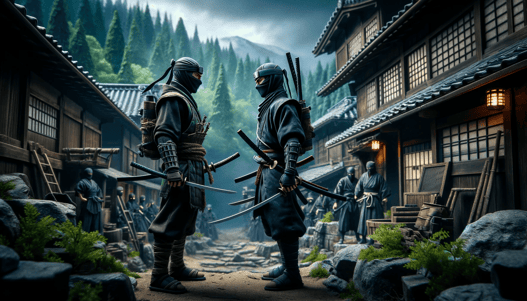
Among the many ninja groups, the Iga-ryu and Koga-ryu are the most well-known. The Iga-ryu was based in present-day Iga, Mie Prefecture, while the Koga-ryu operated in Koka, Shiga Prefecture. These areas were mountainous, making them difficult for outsiders to invade, which allowed unique ninja techniques and traditions to develop.
Another notable ninja group was the "Nokizaru" (軒猿), who served Uesugi Kenshin, a powerful warlord. These ninjas specialized in intelligence-gathering operations in mountain regions, further demonstrating the adaptability and strategic importance of ninjas.
■ The Hierarchical Structure of Ninjas
%20in%20a%20feudal%20Japan%20setting.%20The%20image%20should%20show%20three%20distinct%20ninja%20classes%20(1)%20(1).jpg?width=551&height=315&name=DALL%C2%B7E%202025-03-08%2016.21.59%20-%20A%20historical%20depiction%20of%20the%20hierarchical%20structure%20of%20ninjas%20(shinobi)%20in%20a%20feudal%20Japan%20setting.%20The%20image%20should%20show%20three%20distinct%20ninja%20classes%20(1)%20(1).jpg)
Ninjas were organized into a hierarchical system based on their roles and skills.
- Jonin (上忍): The highest-ranking ninjas who planned strategies and gave orders.
- Chunin (中忍): Mid-level ninjas who executed missions under the guidance of Jonin.
- Genin (下忍): The lower-ranked ninjas who carried out infiltrations and direct combat operations.
This structured system allowed ninjas to function efficiently and effectively in their missions.

Ninjas, due to their secretive nature, have inspired numerous legends and stories. Even today, they continue to attract significant interest both in Japan and internationally as a symbol of Japanese culture. Deeply rooted in Japanese history and traditions, ninjas remain a fascinating subject that blends historical reality with myth, capturing the imagination of people worldwide.
2. The History of Ninjas
1. The Origins of Ninjutsu and Its Founders (Before the 14th Century)
%20in%20ancient%20Japan%2c%20around%20the%2014th%20century.%20The%20scene%20takes%20place%20in%20a%20mountainous%20region%20like%20Iga%20or%20.jpg?width=527&height=301&name=DALL%3FE%202025-03-08%2015.49.08%20-%20A%20historical%20depiction%20of%20early%20ninjas%20(shinobi)%20in%20ancient%20Japan%2c%20around%20the%2014th%20century.%20The%20scene%20takes%20place%20in%20a%20mountainous%20region%20like%20Iga%20or%20.jpg)
Ninjas (also known as Shinobi) do not have a single, definitive founder or clear origin. Instead, they gradually emerged throughout Japan’s ancient and medieval periods. Their techniques are believed to have developed through a combination of the espionage strategies found in Sun Tzu’s The Art of War, the knowledge of mountain ascetics, and the skills of covert agents (spies).
In particular, the mountainous regions of Iga (present-day Mie Prefecture) and Koka (present-day Shiga Prefecture) saw the evolution of unique self-defense techniques, which later formed the foundation of ninjutsu. The first known historical record mentioning ninjas appears in the 14th-century Taiheiki, which describes how a warlord named Ko no Moronao (高師直) employed "Shinobi" for espionage and warfare.
Ninjutsu was later systematized in written form during the Edo period (17th–19th century). One of the most important texts, the Bansenshukai (万川集海, "The Book of Ten Thousand Rivers"), compiled in 1676, provides a detailed account of ninja techniques, philosophy, and strategy. This document remains a key reference for understanding historical ninja practices today.
2. The Historical Background of Ninja Activities (14th–17th Century)
%20during%20the%20Sengoku%20period%20(14th-17th%20century)%20in%20Japan.%20The%20scene%20illustrates%20a%20group%20of%20ninjas%20dressed%20in%20.jpg?width=525&height=300&name=DALL%3FE%202025-03-08%2015.49.05%20-%20A%20historical%20depiction%20of%20ninjas%20(shinobi)%20during%20the%20Sengoku%20period%20(14th-17th%20century)%20in%20Japan.%20The%20scene%20illustrates%20a%20group%20of%20ninjas%20dressed%20in%20.jpg)
During the Muromachi period (14th century) and the Sengoku period (15th–16th centuries)—a time of continuous warfare in Japan—ninjas became increasingly important as mercenaries for feudal lords (daimyo). In regions like Iga and Koka, powerful ninja clans formed semi-autonomous organizations, resisting external control while also offering their services to various warlords as needed.
Ninja missions varied widely, including:
- Espionage: Disguising themselves as civilians to infiltrate enemy territories.
- Disinformation campaigns: Spreading false intelligence to mislead opponents.
- Night raids: Sneaking into enemy castles to commit acts of sabotage, such as arson.
- Assassinations and kidnappings: Targeting enemy commanders or key figures.
Ninjas were highly skilled in unconventional warfare, utilizing weapons such as:
- Kodachi (小太刀, short swords) and kusarigama (鎖鎌, chain-sickle) for close combat.
- Blowguns (吹き矢) and explosive devices for silent or long-range attacks.
- Rope ladders and grappling hooks for scaling walls.
- Caltrops (makibishi, 撒菱) to slow down pursuing enemies.
The Iga Rebellion (1581) was a pivotal moment in ninja history. The powerful warlord Oda Nobunaga invaded Iga Province, seeking to suppress its independent ninja clans. Despite fierce resistance, Nobunaga’s forces ultimately overwhelmed the Iga warriors. Many surviving ninjas fled to other regions, offering their skills to various feudal lords.
3. Ninjas in the Edo Period (17th–19th Century)
%20during%20the%2017th%20to%2019th%20century%20in%20Japan.%20The%20scene%20showcases%20ninjas%20employed%20by%20the%20Tokugawa%20sh.jpg?width=526&height=300&name=DALL%3FE%202025-03-08%2015.49.03%20-%20A%20historical%20depiction%20of%20Edo%20period%20ninjas%20(shinobi)%20during%20the%2017th%20to%2019th%20century%20in%20Japan.%20The%20scene%20showcases%20ninjas%20employed%20by%20the%20Tokugawa%20sh.jpg)
With the establishment of the Tokugawa Shogunate in 1603, Japan entered a long period of peace. As large-scale wars declined, the role of ninjas shifted from military operations to intelligence gathering and security services.
The first Tokugawa shogun, Tokugawa Ieyasu, recognized the value of ninjas and incorporated Iga and Koka ninjas into the shogunate’s security forces. The famous ninja leader Hattori Hanzo played a crucial role in these efforts, helping to secure Edo Castle and overseeing espionage activities. Ninjas also served in government spy networks, such as the Onmitsu (隠密, covert agents) and the Oniwaban (御庭番, "Garden Keepers"), who gathered intelligence on rival factions and monitored feudal lords.
However, as Japan stabilized, the need for ninja warriors declined. By the 18th century, many former ninjas had transitioned into farmers, government officials, or minor samurai retainers. Meanwhile, ninjas began to appear in Kabuki theater and literature, portrayed as legendary warriors with supernatural abilities. This era gave rise to famous fictional ninja figures such as Ishikawa Goemon and Sarutobi Sasuke.
4. The Evolution of the Ninja Image in Modern Times (19th Century–Present)

The Meiji Restoration (1868) marked the end of Japan’s feudal era, leading to the abolition of the samurai class and the complete decline of ninjas as a functional profession. However, by the late 19th and early 20th centuries, ninja stories regained popularity through pulp novels and serialized fiction, introducing characters like Sarutobi Sasuke and Kirigakure Saizo, who became widely recognized ninja heroes.
In the early 20th century, ninjas also began appearing in silent films, where dramatic special effects—such as "vanishing in a puff of smoke"—became standard tropes. After World War II, the 1950s and 60s saw a boom in ninja fiction, with authors like Yamada Futaro producing the bestselling "Koga Ninpocho" (甲賀忍法帖, "The Koga Ninja Scrolls") series. These novels inspired numerous films and TV dramas, cementing the modern perception of ninjas.
By the late 20th century, the ninja craze extended worldwide through manga, anime, and Hollywood films. Iconic works such as "Kamui Gaiden", "NARUTO", and various action movies helped shape the global image of ninjas as stealthy, powerful warriors.

Today, historical ninja research has advanced significantly. In 2017, Mie University established the world's first academic ninja studies program, focusing on the history and techniques of real ninjas. Visitors can also explore ninja history firsthand at places like the Iga-ryu Ninja Museum and Koka Ninja Village, where traditional ninja techniques and artifacts are preserved.
Thanks to their widespread representation in movies, games, and pop culture, ninjas have become one of Japan’s most recognizable cultural symbols, admired by people around the world.
3. Ninja Equipment
Ninjas were highly skilled in using a variety of weapons and tools. Their primary equipment included the following:
・Kasha Ken (火車剣)
.%20The%20weapon%20is%20a%20cross-shaped%20shuriken%20wit.jpg?width=526&height=300&name=DALL%3FE%202025-03-08%2016.10.12%20-%20A%20highly%20realistic%2c%20wide-angle%20depiction%20of%20a%20historical%20ninja%20weapon%20called%20_Kasha-Ken_%20(Fire%20Wheel%20Sword).%20The%20weapon%20is%20a%20cross-shaped%20shuriken%20wit.jpg)
The Kasha Ken was a special type of shuriken that ninjas were believed to have used. It featured a cross-shaped shuriken wrapped with a slow-burning fuse and contained gunpowder at its core. When ignited and thrown, the Kasha Ken would catch fire in mid-air, serving as both a light source and an incendiary weapon. This tool was not only designed to create confusion among enemies but also to support covert operations.
However, historical records mentioning the actual use of the Kasha Ken are scarce. It is mostly referenced in later legends and fictional accounts. Therefore, the extent to which this weapon was truly utilized remains uncertain, and it is not widely accepted as a confirmed historical fact.
・Kusarigama (鎖鎌)
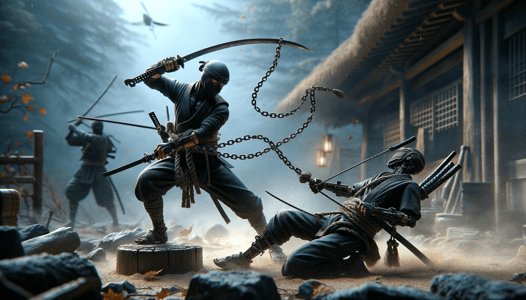
The Kusarigama was a weapon used by both ninjas and certain samurai during the Sengoku period. It consists of a sickle (kama) attached to a weighted chain. The typical combat technique involved swinging the weighted chain to entangle the enemy’s weapon or limbs, thus restricting their movement. Once immobilized, the ninja would then strike with the sickle to finish the attack.
The length of the chain and the weight of the metal counterbalance allowed for both offensive and defensive techniques. A skilled user could disarm an opponent, strike them with the weight, or even use the chain to restrain an enemy. However, mastering the Kusarigama required advanced training and skill.
・Shinobi Gama (忍び鎌)
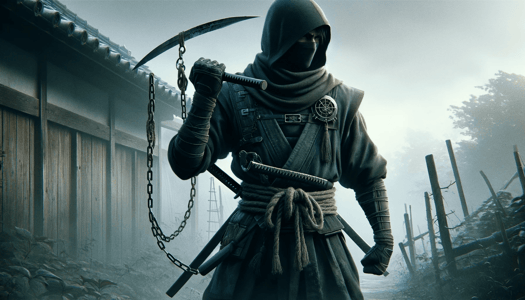
The Shinobi Gama was a weapon disguised as a common farming sickle (kama), allowing ninjas to blend into agricultural communities while carrying a concealed weapon. Though it appeared to be an ordinary tool, it was designed for combat and stealth attacks. Some versions were modified by adding a chain, effectively turning them into Kusarigama.
This weapon was particularly useful for night missions and infiltration operations, allowing ninjas to approach enemies undetected and launch surprise attacks. The clever design enabled ninjas to use it as both a daily farming tool and a deadly weapon when necessary.
・Manrikigusari (万力鎖)

The Manrikigusari, or "Ten-Thousand Power Chain," was a chain weapon with weighted ends that used centrifugal force for both offense and defense. It was primarily used for defensive purposes, allowing a ninja to swing the weights to block enemy attacks, strike opponents, or entangle their weapons.
This weapon required advanced skill, as its effectiveness depended on the force of the swing and the weight of the chain. The Manrikigusari was particularly useful in self-defense and combat situations where a ninja needed to disable an enemy without resorting to lethal force. It was employed by both ninjas and some samurai, valued for its versatility in both offensive and defensive strategies.
・Makibishi (巻き菱)

Makibishi were spiked caltrops used by ninjas to impede enemy movement and create escape opportunities. These sharp metal or bamboo spikes were designed to always land with at least one spike pointing upward, ensuring that anyone who stepped on them would suffer pain and injury.
Makibishi were particularly effective when used during chases or ambushes. Ninjas would scatter them on roads or in corridors to slow down pursuing enemies, making them an invaluable tool for evasion tactics. Their simple yet effective design made them one of the most recognizable ninja tools, especially for night missions and combat in low-visibility conditions.
・Kakute (角指)
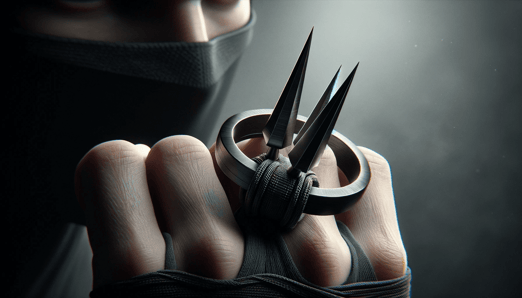
Kakute were metal rings worn on the fingers, often featuring sharp protrusions. They were similar in function to modern brass knuckles, enhancing the striking power of a ninja’s punches. These rings could be used in hand-to-hand combat to deliver painful blows or to apply pressure to vital points on an opponent’s body.
Ninjas primarily used Kakute for self-defense during stealth operations. Their compact and concealable design made them ideal for surprise attacks or close-quarters combat. The ability to wear them discreetly allowed ninjas to catch their enemies off guard, delivering powerful and unexpected strikes.
・Horokubiya (焙烙火矢)
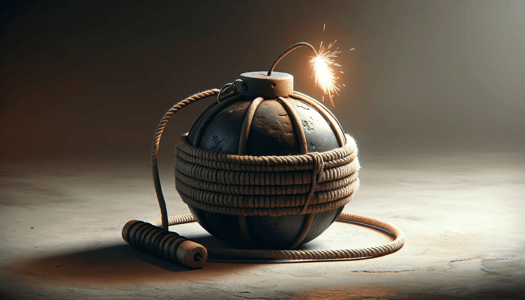
The Horokubiya was a small explosive device used by ninjas, made from earthenware pots filled with gunpowder. These bombs were employed in sieges and infiltration missions, where they could be thrown or launched with arrows to create explosions.
Ninjas often used the Horokubiya to set enemy buildings on fire, cause chaos, or lower enemy morale. These devices played a crucial role in psychological warfare, forcing enemies into panic and confusion. Due to their destructive power, they were considered one of the most effective ninja weapons for sabotage.
・Tekko-Kagi (手甲鉤)
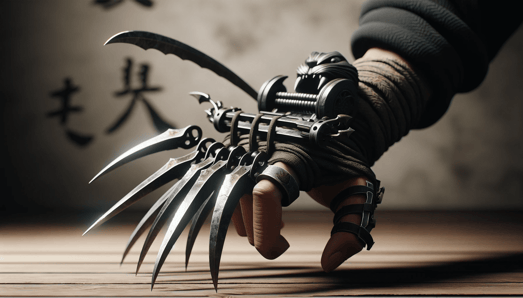
The Tekko-Kagi was a clawed gauntlet, primarily used for both offensive and defensive purposes. This weapon consisted of a protective handguard with metal claws, allowing ninjas to hook, block, or slash at enemies.
Ninjas could use the Tekko-Kagi to disarm opponents, trap weapons, or climb surfaces. It was especially effective in close combat, where it could be used to rip through armor or entangle an enemy’s limbs. The intimidating appearance of the Tekko-Kagi also served a psychological purpose, striking fear into opponents.
・Kunai (くない)

The Kunai was an iron blade with a pointed tip, used for a variety of purposes beyond combat. Originally a digging and prying tool, it was repurposed by ninjas for stabbing, cutting, and climbing.
Ninjas used the Kunai as a throwing weapon, a dagger for close combat, and even as a makeshift grappling hook. They could also hammer it into walls to create footholds or use it to dig tunnels and break locks. Due to its versatility and durability, the Kunai was considered one of the most essential ninja tools.
・Shuriken (手裏剣)

The Shuriken was a small throwing weapon designed to injure or distract enemies. These weapons came in various shapes, including cross-shaped, needle-like, and star-shaped forms.
Ninjas used Shuriken not only as lethal projectiles but also as tools for misdirection and diversion. While they were rarely used for direct kills, they could be dipped in poison or used to wound and weaken opponents. Additionally, Shuriken were effective for disrupting enemy formations and creating escape opportunities.
Due to their small size and easy concealment, Shuriken became one of the most iconic ninja weapons, often associated with their stealth and precision.
4. Places to Experience Ninjas in Japan
If you want to step into the world of ninjas, Japan offers a variety of places where you can experience ninja culture firsthand. From historical theme parks to hands-on training in the mountains, here are some of the best places to immerse yourself in the art of the ninja.
・Noboribetsu Date Jidaimura (Hokkaido)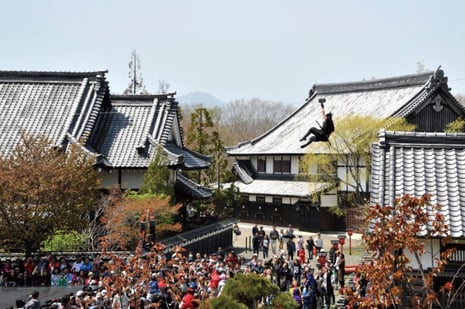
This Edo-period themed park recreates the streets of historical Japan, allowing visitors to experience the daily life of samurai, townspeople, and, of course, ninjas. One of the main highlights is the ninja show, featuring impressive acrobatics and battle performances.
Visitors can also try shuriken (throwing stars), archery, and explore a ninja trick house filled with hidden doors and secret passages. In addition to ninja activities, the park offers Edo-style dining experiences, making it a fun and immersive cultural adventure.
・Yajin-ryu Ninjutsu "No-Nin" (Tokyo)
For those looking for a real ninja training experience, Yajin-ryu Ninjutsu "No-Nin" offers an authentic ninja survival course in the mountains of Akiruno, Tokyo.
Unlike standard ninja-themed entertainment, this program focuses on practical ninja skills, including shuriken throwing, blowgun techniques, stealth movement, and survival training. This is an ideal experience for those who want to learn the philosophy and techniques of historical ninjas in a hands-on way.
・Oshino Shinobi-no-Sato (Yamanashi)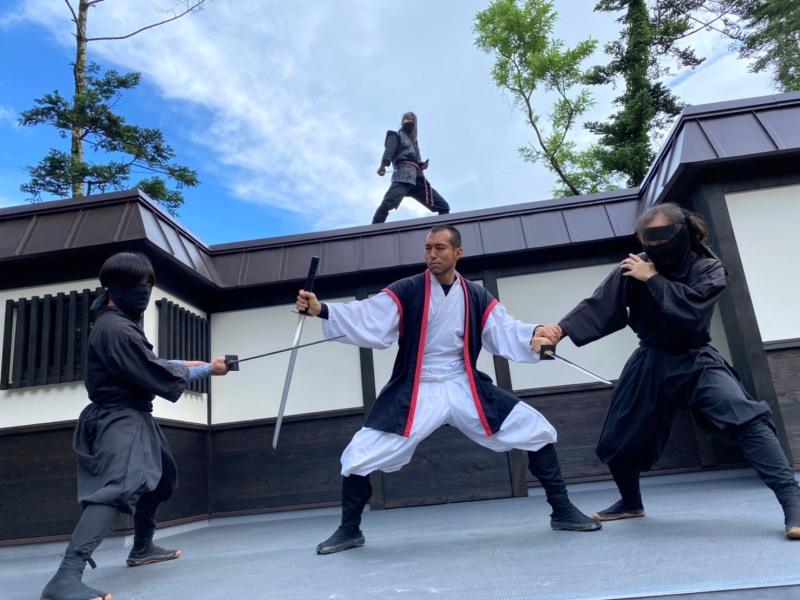
Located at the foot of Mt. Fuji, this ninja theme park offers a variety of activities suitable for all ages. Visitors can try shuriken, archery, and blowguns, while also enjoying live ninja performances showcasing the agility and skills of real ninja actors.
The park features a beautiful Japanese garden, providing a picturesque setting for visitors to dress up in ninja costumes and take photos. Whether you're a history enthusiast or simply looking for a fun activity, this park offers an engaging ninja experience.
・Togakushi Folk Museum & Togakure-ryu Ninja Museum (Nagano)
This museum is dedicated to the history and techniques of the Togakure-ryu ninja tradition, one of Japan’s most famous ninja schools. The Ninpoh-kan (Ninja Treasure Hall) displays authentic ninja tools, weapons, and secret scrolls, providing a deep insight into ninja history.
Visitors can explore a "Karakuri Yashiki" (Ninja Trick House), which features hidden doors and secret passages. The museum also offers a ninja training area for children, where they can test their skills through obstacle courses and ninja challenges.
・Shuriken Dojo & Shinjuku Ninja Karakuri Yashiki (Tokyo)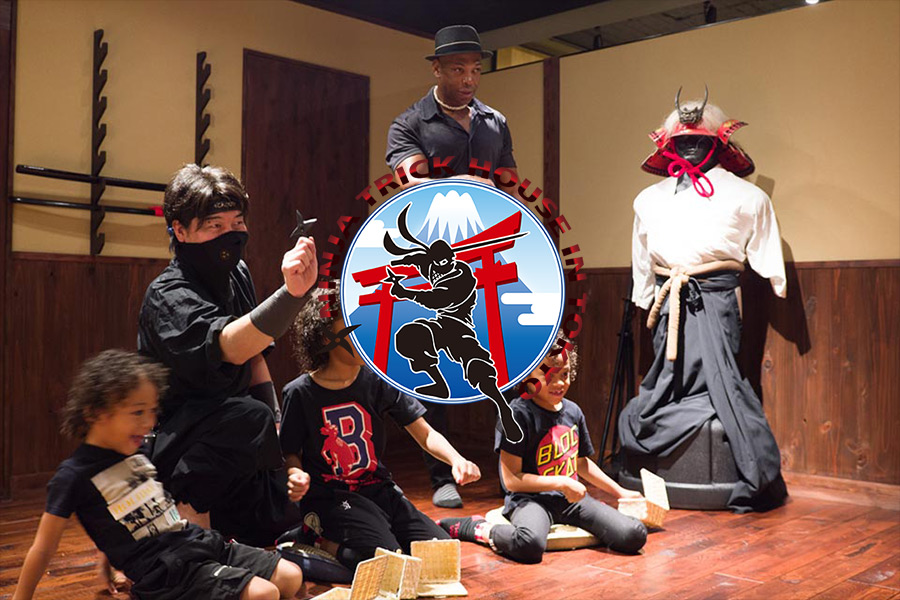
Located in the heart of Shinjuku, this ninja entertainment facility allows visitors to experience ninja tactics and traditional weapons up close. One of the most exciting activities is the "Karakuri Search," where participants must uncover hidden doors and secret rooms just like a real ninja.
The shuriken throwing experience lets visitors try real iron shuriken, while other activities include sword techniques and the use of caltrops (makibishi) for battlefield strategy. This is one of the most convenient places in Tokyo to enjoy a fun and interactive ninja experience.
Conclusion
From historical theme parks to authentic training experiences, Japan offers a variety of ways to explore ninja culture. Whether you're interested in learning real ninja skills or simply watching exciting performances, these destinations provide unforgettable opportunities to step into the world of the ninja.
